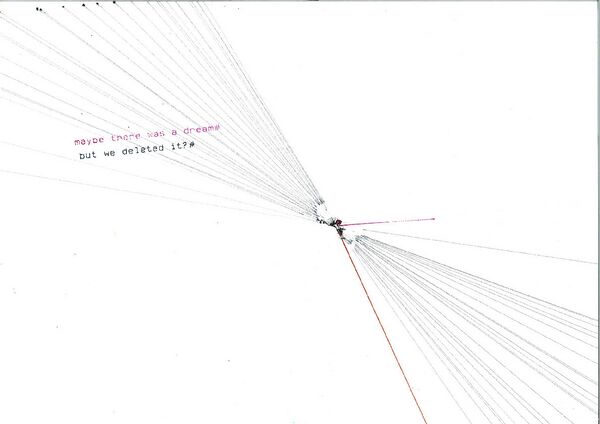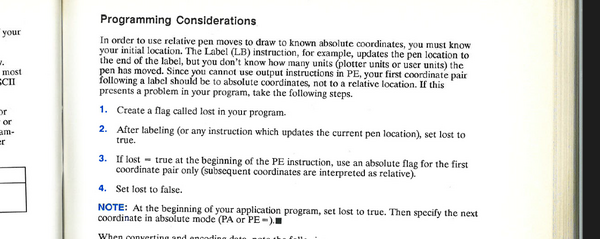User:Ssstephen/prototype/20231113: Difference between revisions
No edit summary |
No edit summary |
||
| (3 intermediate revisions by one other user not shown) | |||
| Line 50: | Line 50: | ||
</pre> | </pre> | ||
[[File:Setlosttotrue.png| | [[File:Setlosttotrue.png|600px]] | ||
<br style="clear:both;"> | |||
<small>set lost to true</small> | |||
the data being collected in the script that i can see: | the data being collected in the script that i can see: | ||
| Line 119: | Line 121: | ||
</pre> | </pre> | ||
so in summary the script gives bigger gestures the less work is done by the rodent (the longer the times between gestures on the trackpad). It is a celebratory performance of laziness. It encourages working less. There is an inverse relationship between | [[File:Scan MFP-528 3116 001 Page 1.jpg|600px]] | ||
<br style="clear:both;"> | |||
<small>plotting and doubting irrationally</small> | |||
so in summary the script gives bigger gestures the less work is done by the rodent (the longer the times between gestures on the trackpad). It is a celebratory performance of laziness. It encourages working less. It measures the opposite of time and translates it to vectors. There is an inverse relationship between busy-ness/business and the intensity of the performed gestures. | |||
to do: should the hpgl commands be relative instead of absolute? it would be more lost then which would be nice. | to do: should the hpgl commands be relative instead of absolute? it would be more lost then which would be nice. | ||
Its something to do with gregory bateson and christopher small and taylorism and Frank and Lillian Gilbreth. Joseph says talk to steve rushton about it. is the language getting too abstract or is that the point? | |||
https://www.cambridge.org/core/journals/dialogue-canadian-philosophical-review-revue-canadienne-de-philosophie/article/phenomenology-of-gesture-between-heidegger-and-flusser/7730314A14E992C2C6F913D661107989 | |||
https://zetabooks.com/wp-content/uploads/introSP22.pdf | |||
Latest revision as of 16:00, 12 February 2024
rodent trace ornamentation
a few weeks ago i made a script that saves my mouse actions to a text file. and by made I mean i pressed, among other buttons, ctrl+c and ctrl+v.
from pynput.mouse import Listener
import logging
logging.basicConfig(filename="mouse_log.txt", level=logging.DEBUG, format='%(asctime)s: %(message)s')
def on_move(x, y):
logging.info("Mouse moved to ({0}, {1})".format(x, y))
def on_click(x, y, button, pressed):
if pressed:
logging.info('Mouse clicked at ({0}, {1}) with {2}'.format(x, y, button))
def on_scroll(x, y, dx, dy):
logging.info('Mouse scrolled at ({0}, {1})({2}, {3})'.format(x, y, dx, dy))
with Listener(on_move=on_move, on_click=on_click, on_scroll=on_scroll) as listener:
listener.join()
today I want to send that data to the plotter instead in a language it understands. i want to do this as a way of ornamenting and documenting the work that happens through the mouse or trackpad. pen plotters are often used for presentations: it is about finding what is between the past and the future. i want to try not to focus on the cartesian coordinates in the data but they might be useful. the data looks kind of like this:
2023-10-25 12:17:36,329: Mouse moved to (1816, 799) 2023-10-25 12:17:36,337: Mouse moved to (1814, 799) 2023-10-25 12:17:36,345: Mouse moved to (1812, 799) 2023-10-25 12:17:36,353: Mouse moved to (1809, 800) 2023-10-25 12:17:36,361: Mouse moved to (1807, 801) 2023-10-25 12:17:36,369: Mouse moved to (1805, 801) 2023-10-25 12:17:36,376: Mouse moved to (1803, 801) 2023-10-25 12:17:36,385: Mouse moved to (1800, 801) 2023-10-25 12:17:36,393: Mouse moved to (1799, 801) 2023-10-25 12:17:36,401: Mouse moved to (1798, 801) 2023-10-25 12:17:36,553: Mouse clicked at (1798, 801) with Button.left 2023-10-25 12:17:36,729: Mouse clicked at (1798, 801) with Button.left 2023-10-25 12:17:37,440: Mouse moved to (1798, 801) 2023-10-25 12:17:37,953: Mouse scrolled at (1798, 801)(0, -1) 2023-10-25 12:17:37,969: Mouse scrolled at (1798, 801)(0, -1) 2023-10-25 12:17:37,977: Mouse scrolled at (1798, 801)(0, -1) 2023-10-25 12:17:37,993: Mouse scrolled at (1798, 801)(0, -1) 2023-10-25 12:17:38,009: Mouse scrolled at (1798, 801)(0, -1) 2023-10-25 12:17:38,033: Mouse scrolled at (1798, 801)(0, -1) 2023-10-25 12:17:38,040: Mouse scrolled at (1798, 801)(0, -1) 2023-10-25 12:17:38,057: Mouse scrolled at (1798, 801)(0, -1) 2023-10-25 12:17:38,065: Mouse scrolled at (1798, 801)(0, -1)
the data being collected in the script that i can see:
- something happened (listener)
- it happened now (asctime)
- by something, it was either a click, move or scroll
- it happened somewhere xy (this is presented as if it's two pieces of information, weird)
- if it was a click, it involved a particular button (strange my trackpad does not have buttons)
- if it was a scroll it moved to another relative position dxdy#
how to track and dance with the work done by the rodent? how long has it been since you last did something? the longer its been, the further you move. the direction isnt important yet.
Its working. the longer I take to move the mouse, the longer the line becomes. the script is like this:
# It sends your mouse data to the pen plotter to see
# what you're up to over there.
from chiplotle3 import *
import math
import random
import time
from pynput.mouse import Listener
import logging
# initialise chiplotle
plotter = instantiate_plotters( )[0]
t0 = 0
t1 = 0
dt = 0
x = 0
y = 0
notplotting = 1
eventwaiting = 0
button = "0"
coords = []
plotter.select_pen(1)
plotter.write(hpgl.PU([(0,0)]))
print("init done")
def on_move(x, y, button="Left", pressed="1"):
#logging.info("Mouse moved to ({0}, {1})".format(x, y))
global t0
global t1
global dt
global notplotting
t0 = t1
t1 = time.time()
dt = (t1-t0)*1000
print("new move length is " +str(dt))
if dt > 3000:
plotnow(dt)
def plotnow(dt):
print("plottin now")
dx = int(dt/100)
plotter.write(hpgl.PU([(0,0)]))
plotter.write(hpgl.PD([(-dt,7000)]))
time.sleep(0.1)
with Listener(on_move=on_move, on_click=on_move, on_scroll=on_move) as listener:
listener.join()

plotting and doubting irrationally
so in summary the script gives bigger gestures the less work is done by the rodent (the longer the times between gestures on the trackpad). It is a celebratory performance of laziness. It encourages working less. It measures the opposite of time and translates it to vectors. There is an inverse relationship between busy-ness/business and the intensity of the performed gestures.
to do: should the hpgl commands be relative instead of absolute? it would be more lost then which would be nice. Its something to do with gregory bateson and christopher small and taylorism and Frank and Lillian Gilbreth. Joseph says talk to steve rushton about it. is the language getting too abstract or is that the point?

